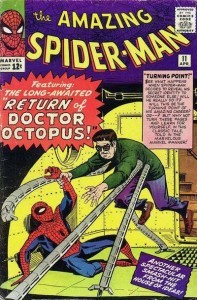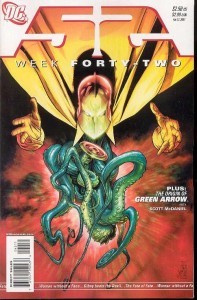Daniel Sherrier's Blog, page 38
July 3, 2016
Today’s Super Comic — All-New X-Men #4 (2016)
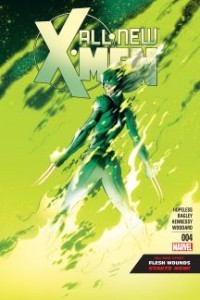 Back in 2012, writer Brian Michael Bendis kicked off a brilliant concept—plucking the original teenage X-Men from their relatively innocent youth, sending them forward in time, and dropping them in the middle of the convoluted present-day continuity.
Back in 2012, writer Brian Michael Bendis kicked off a brilliant concept—plucking the original teenage X-Men from their relatively innocent youth, sending them forward in time, and dropping them in the middle of the convoluted present-day continuity.
I would have thought Bendis and/or other writers would have resolved this tale of time-displaced X-Men by now. But I’m glad they haven’t. They haven’t nearly exhausted the creative possibilities yet, as evidenced by the relaunched All-New X-Men title, written by Dennis Hopeless and drawn by Mark Bagley.
I picked up the first trade paperback, and while the whole thing is solid the strongest issue within is the fourth, which kicks off the second storyline. By this point, the mission statement of the series comes into focus—this series will follow a group of seven young mutants trying to figure out their crazy lives and seize their own destinies after the adult Cyclops has totally made a mess of things.
The cast consists of the time-displaced younger versions of Cyclops, Beast, Iceman, and Angel (Jean Grey is hanging out with the adults in Extraordinary X-Men), the young female clone of Wolverine, and Idie and Kid Apocalypse from Wolverine and the X-Men. Too many X-titles over the past twenty-some years have juggled too many characters, so narrowing the focus to just these seven is a wise move.
Angel and the new Wolverine’s relationship gets the most attention in this particular issue, but every character is grappling with some personal problem or another. Cyclops’s is the most interesting—he’s seen that he’ll grow up to become basically a villain, so how does he avoid a future that has already played out?
Also, Angel and Wolverine run into the Blob, who’s a bit more formidable than he was in the good ol’ days.
Fun stuff so far, and I suspect the best is yet to come.
Writer: Dennis Hopeless
Penciler: Mark Bagley
Publisher: Marvel Comics
How to Read It: recent back issues; Comixology; included in All-New X-Men: Ghosts of Cyclops (TPB)
Appropriate For: ages 11 and up
July 2, 2016
Today’s Super Comic — The Sandman #31 (1991)
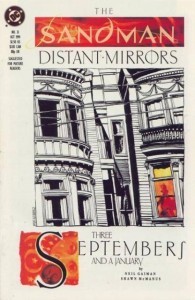 Neil Gaiman’s Sandman featured many excellent short stories throughout its run, and those single-issue stories tended to be even more interesting when they featured historical characters…such as the Emperor of the United States in #31.
Neil Gaiman’s Sandman featured many excellent short stories throughout its run, and those single-issue stories tended to be even more interesting when they featured historical characters…such as the Emperor of the United States in #31.
Yes, a San Francisco man, Joshua Norton, actually did proclaim himself the first U.S. emperor in the 19th century, and people humored him and played along without letting him have any real authority. He’s the perfect subject for a Sandman guest star. Gaiman chose well indeed, and he uses Norton’s story to show how dreams can defeat despair—even dreams that are completely bonkers.
And of course, with this being Sandman, dreams and despair are Dream and Despair, two of the Endless. Their siblings, Delirium and Desire, also try to claim Norton, but Dream’s inspiration gives the troubled man a way to get through life without hurting himself or anyone else. Rather, Norton becomes an eccentric public figure who, however inadvertently, delights the residents and visitors of San Francisco. He may not be contributing to society in quite the way he intends—not even close, really—but he contributes. And the right dream allows him to do that.
An utterly fascinating story that will make you want to do a Google search immediately afterward.
Writer: Neil Gaiman
Penciler: Shawn McManus
Publisher: DC Comics (Vertigo)
How to Read It: back issues; Comixology; included in The Sandman vol. 6: Fables & Reflections (TPB)
Appropriate For: ADULTS ONLY
July 1, 2016
Today’s Super Comic — The Amazing Spider-Man #11 (1964)
The best comic book series in the 1960s was easily The Amazing Spider-Man. More than any other book at the time, Spider-Man put character first and did so without skimping on the excitement. It set the template for many teenage superheroes to follow, but at the time there wasn’t anything quite like it.
Issue #11 serves as a great example of a typically solid ‘60s Spidey story, incorporating relationship drama, well-choreographed action, and a fallible hero. I first read this one as a kid in the ‘90s, about thirty years after it debuted, and I loved it. It’s not timeless, but it holds up remarkably well compared to its contemporaries.
Doctor Octopus returns for (I think) only his second appearance…and who’s that picking him up as he’s released from prison? Why, it’s Betty Brant, Daily Bugle secretary and Peter Parker’s first girlfriend. How about that? Should Peter maybe reconsider his decision to tell her he’s Spider-Man?
Stan Lee’s story is plenty engaging, and Steve Ditko’s layouts bring the action to life. And to spice up the typical hero/villain confrontation, Spidey sprains his ankle right before the fight starts. And that’s classic Spider-Man in a nutshell—he’s the guy who hurts himself before the bad guys even get the chance.
Writer: Stan Lee
Penciler: Steve Ditko
Publisher: Marvel Comics
How to Read It: back issues; Marvel Unlimited; Comixology; included in The Essential Spider-Man vol. 1 (TPB)
Appropriate For: ages 8 and up
Today’s Super Comic — Doctor Strange #3 (2015)
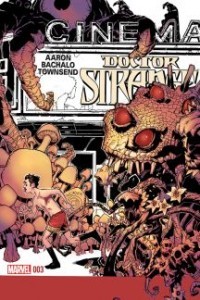 Writer Jason Aaron and artist Chris Bachalo continue to have fun with Doctor Strange. Looks like they’re getting the character in good shape for this year’s movie.
Writer Jason Aaron and artist Chris Bachalo continue to have fun with Doctor Strange. Looks like they’re getting the character in good shape for this year’s movie.
The visuals take the lead in the current series’ third issue, the latest available on Marvel Unlimited (not really “unlimited” then, is it?), as monsters chase Doctor Strange’s astral form across New York. It’s a great way to showcase Strange’s resourceful and knowledge while letting Bachalo cut loose with imaginative pages.01
And it continues to set up a larger plot involving some not-nice people wanting to kill all magic, so that should be fun, too.
This creative team is the first to get me interested in an ongoing Doctor Strange series. Well done.
Writer: Jason Aaron
Penciler: Chris Bachalo
Publisher: Marvel Comics
How to Read It: recent back issues; Marvel Unlimited; Comixology; included in Doctor Strange: The Way of the Weird (HC)
Appropriate For: ages 13 and up
June 30, 2016
Avenging The Fantastic, Part 13: The Black Widow Goes Solo (Briefly)!
Continuing the read-through of as many Avengers and Fantastic Four–related Marvel comics as possible!
Books Read
Fantastic Four #94-104; Avengers #73-83; Captain America #121-133, Captain America and the Falcon #134; Iron Man #21-32; Incredible Hulk #125-134; Thor #172-181; Amazing Adventures (starring Black Widow) #1-4; years: 1970-71
The Revolving Door of Avengers Mansion
Yellowjacket and Wasp are out so Hank Pym can do science for the government, but Quicksilver and the Scarlet Witch are back, thus filling the Avengers’ quota of unhealthy relationships. And then the Vision abruptly leaves shortly later…and returns almost immediately.
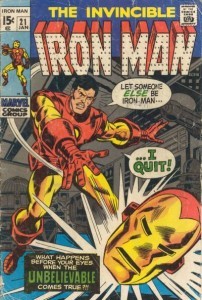 The Best of This Bunch – Iron Man #21-22
The Best of This Bunch – Iron Man #21-22
Archie Goodwin’s solid run on Iron Man continues with a tale of Tony Stark trying to quit his superhero life…and realizing he can’t. The story features tropes that have become too commonplace these days—a replacement for the hero, a replacement for an old villain, and the death of a romantic interest. But these tropes were fresher in 1970 and, in this particular instance, well-handled.
Iron-willed boxer and all-around decent guy Eddie March makes for a likeable potential Iron Man, though he has a medical condition of his own that cuts his super-heroic career short. Surprisingly, he survives the tale, but Janice Cord’s death comes out of nowhere.
Janice had been portrayed as a potential girlfriend for Tony Stark for the past twenty issues or so. Now, after an experimental medical procedure leaves Tony Stark’s heart healthy enough for daily life but not necessarily superhero life, he decides to pursue a normal relationship and pass the Iron Man armor onto a worthy successor.
However, Janice hasn’t sprung to life as a particularly memorable or compelling character…so she must die, naturally. In the story’s defense, back in these days, any character who lasted beyond his or her first or second appearance wasn’t likely to die ever. So at the time, this was a somewhat bold story decision on Goodwin’s part, even though to modern sensibilities, the automatic reaction tends to be, “Ugh, another woman killed to provide motivation for the male hero?”
Goodwin’s run ends several issues later, and the drop in quality is steep.
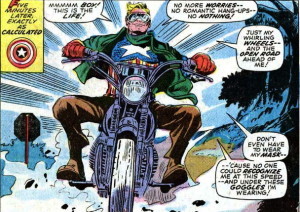 Cap saves Woodstock! – Captain America #128
Cap saves Woodstock! – Captain America #128
He saves it from a misguided gang of bikers. A sanitized version of Woodstock, anyway.
But first, Cap buys a motorcycle! And a cop pulls Steve Rogers over for riding it without a helmet, leading to this scintillating exchange: “Where’s your helmet, Mac?” “Helmet? I—I didn’t even think of it!” “That’s your hard luck! We’ve got no use for you souped-up hotshots here anyway! So get off that cycle! I’m running you in!” And Cap goes to jail—because the cop believes him to be associated with a gang of law-breaking bikers, not just for the helmet. Not really a ton of just cause in any case.
Also, the issue depicts…yet again…the flashback scene where Bucky dies. But in earlier versions, Cap and Bucky are shown wearing Army fatigues, and this time, they’re dressed in costume. A couple of captions address this inconsistency. The first explains that Cap’s memory is embellishing the details, and the second admits that the Marvel crew really just goofed so they came up with this B.S. explanation because they thought it sounded better. When working on a character like Captain America, you can only be honest.
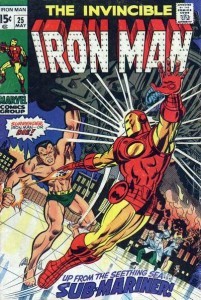 Iron Man vs. Pollution! – Iron Man #25
Iron Man vs. Pollution! – Iron Man #25
Tony Stark is an environmentally conscientious business owner. Alas, not all his employees hold such lofty concerns. One of his project managers goes a little too gung-ho and creates this super-solar-power converter, but he cuts corners (and lots of trees!) in doing so, leading to environmental devastation on the island his crew was working on.
Naturally, in the classic Marvel tradition, this results in Namor the Sub-Mariner fighting Iron Man—and then, after the misunderstanding is resolved, Namor and Iron Man teaming up to save the day by creating a tidal wave that washes over the island (because that’s how you fight air pollution?).
The issue ends with the preachification of Tony Stark, as he warns his businessmen peers about the environmental risks of their work. The calamity that befell Stark’s island “could happen on a global scale within the next ten to thirty years!” he says. “We’re starting late, but if we all work together—”
Then he’s cut off by greedy businessmen who are more interested in their bottom lines and “can’t waste … time on theories!”
“Besides…who knows what will really happen in ten or thirty years?” one guy says. “You shouldn’t let the island business upset you…things’ll work out! We’ve got plenty of time!”
The ending is meant to be ominous, and the message that we have to take care of the environment will always be a valid one. However, like all other doomsday predictions, Stark’s falls short of reality. But give credit to Stark for trying to appeal to entrepreneurs rather than legislators.
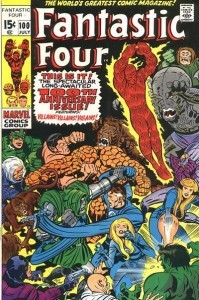 The Fantastic Four vs. Everyone! – Fantastic Four #100
The Fantastic Four vs. Everyone! – Fantastic Four #100
The Fantastic Four make it to their 100th anniversary issue, and to mark the special occasion, Stan Lee and Jack Kirby trot out facsimiles of the team’s major enemies for twenty pages of nonstop, nonsensical action!
It would be nice to say this milestone issue is something special, especially given that it comes so close to the conclusion of Lee and Kirby’s unprecedented 102 consecutive issues of collaborating on the same title, which set a record that wouldn’t be broken until the current century.
Unfortunately, this issue merely demonstrates that it was time for new talent to take over the title. Most of the previous several issues had been rather lacking, and they pale before the bustling imagination demonstrated in the middle part of the Lee/Kirby run. In this issue, the Puppet Master and Mad Thinker create a seemingly endless parade of androids modeled after the FF’s old enemies, and these androids somehow have all the powers and memories of the individuals they’re modeled after. The laws of science tend to be flexible in the FF’s universe, but this defies even old-school comic book logic. And it’s not even in service of any particularly fun action. It’s all kind of meaningless and forgettable. Worst of all, it’s missing the character-driven focus that set this series apart as something special when it debuted.
Nevertheless, ending with a whimper shouldn’t overshadow the wonderful work Lee and Kirby created together in the earlier years. There was a reason Fantastic Four was labeled “The World’s Greatest Comics Magazine,” even if the series’ creators didn’t go out on a high note.
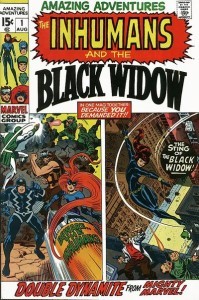 The Black Widow Strikes—On Her Own! – Amazing Adventures #1-4
The Black Widow Strikes—On Her Own! – Amazing Adventures #1-4
First, she was Iron Man’s enemy. Then she was Hawkeye’s girlfriend. Now she’s the star of her own series as a solo superhero. Well, the Black Widow shares Amazing Adventures with an Inhumans feature (which, in the interest of time, I’m not reading). But as she’s got the second half of the book to herself, this marks the first time a Marvel superheroine gets her own ongoing series. It lasts all of eight issues, all of which are only ten pages, but it does offer something different.
The Black Widow faces off against no super-villains in these first four issues. We’re reintroduced to her as a wealthy, bored woman who has turned her back on communism and adopted America as her new home. Craving excitement, she springs into action to help out her housekeeper’s son and winds up befriending a group of Harlem youths who are trying to start a charitable program. The youths illegally occupy a building owned by a corrupt politician—a building they were promised. So, after showing off her impressive fighting abilities against some henchmen, the Widow helps the teens proceed with their program in a legal fashion.
So yeah, it’s different. By the early 1970s, comics were becoming more socially conscious, with some titles pulling their focus away from the larger-than-life melodramatic villains and looking at the plight of the little guy in heavy-handed fashion. DC Comics provided the quintessential example at roughly this same time, Green Lantern/Green Arrow, but the Black Widow’s short-lived series appears to be another vehicle for such stories. She’s well-suited for this street-level role, especially in her pre-Avenger days, post–Communist spy days.
The series deserves credit for diversifying Marvel’s offerings in 1970-71, but it’s nothing extraordinary. However, the art by Gene Colan, beginning in #3, is exceptional.
Meanwhile…
–Reed and Sue Richards’ son finally gets a name: Franklin Benjamin Richards, after Sue’s father and the Thing. That’s what took them multiple weeks of the child’s life to figure out. But they prove far more sensible when it comes to choosing Franklin’s caregiver. They entrust a nice old lady named Agatha Harkness…who happens to be a powerful witch. If you’re the Fantastic Four, that’s just how you roll.
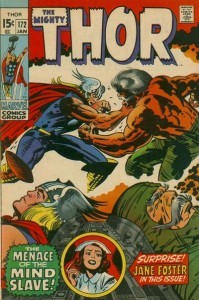 –Jane Foster returns in Thor #172. During her time away, she has neither gained a personality nor lost her predilection toward falling for her employer. And her guest appearance occurs in the weakest issue of Thor since she left. Coincidence?
–Jane Foster returns in Thor #172. During her time away, she has neither gained a personality nor lost her predilection toward falling for her employer. And her guest appearance occurs in the weakest issue of Thor since she left. Coincidence?
–Captain America, in his #122: “Lucky for me the Scorpion didn’t grab my case! It’s about as close as I’ve ever come to having my secret identity exposed!” Except for that time you revealed your secret identity to the whole world, but that was, what, twenty or thirty issues ago? Plenty of time to forget such a trivial life event.
–In #124, Cap gives Nick Fury an ultimatum—take Sharon Carter off of field duty (for her own good!), or SHIELD no longer gets the help of Captain America. He does this without asking Sharon what she wants, but of course she goes along with it…for about three seconds until she has to dive back into the field to save Cap’s life. And what does she get as thanks? Cap accuses her of breaking her word! Says he’s not sure he can ever trust her again! Cap was a jerk in 1970.
–“What? You’re still talking? Well, Hulk will fix that!” –the Hulk says as he proceeds to smash a robot in classic Hulk fashion, in Incredible Hulk #127
–The Black Panther becomes a teacher…because that’s what all kings need—a second job.
–“It looks like I can no more shed my shield-slinging other self—than Nixon can shed ol’ Spiro!” –naïve Captain America, in #129
–“Who cares about that clown [Captain America]? He’s just not relevant in today’s world!” –random youth in Captain America #130
–“The more we can divide this country, and the more we can stifle dissent…the better it will be for—the Hood!” –an old Nazi foe in CA #130. Some of this stuff could have been written today.
–We witness the first inkling of the future Scarlet Witch/Vision relationship in Avengers #81, when Wanda is touched by the lengths the ostensibly cold android is willing to take to protect her.
–The Falcon officially becomes Captain America’s partner in Cap #133.
–Jack Kirby ends his run on Thor with an Odin Ex Machina, as per usual.
–The cover of Iron Man #27 promises, “Introducing…The Firebrand! The most controversial villain in the history of comic-mags!” How can something be controversial before the public is introduced to it?
–“Meantime, Richards—I ask you to remember one thing—we’ve never lost a war before—and I don’t intend to lose one now!” –Richard Nixon (comic book Nixon anyway), Fantastic Four #104
–“They call him—the Monster of Death! I just hope I live long enough to find out why!!” –Tony Stark, genius, on the cover of Iron Man #30
To Be Continued?
Perhaps. But for now, it’s time for this series to go on hiatus for a while. But I will continue reviewing one good comic book a day here until I’ve completed a full year’s worth of positive reviews.
Today’s Super Comics — Green Lantern: Rebirth #1-6 (2004-05)
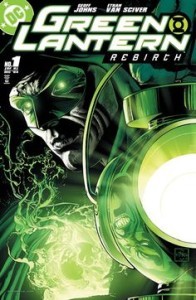 Hal Jordan’s character became a bit of a disaster for several years’ worth of comics. (Though the Green Lantern movie remains the greatest tragedy to befall the character.)
Hal Jordan’s character became a bit of a disaster for several years’ worth of comics. (Though the Green Lantern movie remains the greatest tragedy to befall the character.)
To recap, his hometown was destroyed, he went crazy and beat up his Green Lantern colleagues so he could go yell at the Guardians, the Guardians let him absorb the power of the central GL power battery, Hal became Parallax and nearly destroyed the universe in a company-wide crossover, he languished in the background for a while as a pseudo-villain, he died saving the world in another company-wide crossover, and in yet another company-wide crossover, he became the new Spectre.
And that’s where his character was at when the Green Lantern: Rebirth miniseries rolled around. Hal Jordan, the manifestation of God’s wrath!
Yeah, he needed a rebirth. (But the movie remains worse than all of that.)
Fortunately, writer Geoff Johns came along to untangle this mess and restore Hal as the Earth’s preeminent Green Lantern. Quite a chore indeed, but Johns and artist Ethan Van Scriver succeed in making this deck-clearing exercise incredibly entertaining. Not only do they set the stage for a great run of Green Lantern comics to follow, but they never get farsighted along the way—they make sure the journey of these six issues is a fun ride from start to finish.
This miniseries restores Hal Jordan to greatness and reminds us why the character is great.
Writer: Geoff Johns
Penciler: Ethan Van Scriver
Publisher: DC Comics
How to Read It: back issues; Comixology; Green Lantern: Rebirth (TPB)
Appropriate For: ages 12 and up
June 29, 2016
Today’s Super Comic — Uncanny X-Men #297 (1993)
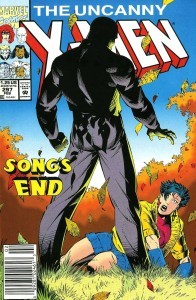 Some of Scott Lobdell’s best X-Men comics were the issues that excluded fisticuffs and super-villains altogether, and Uncanny X-Men #297 is a superb example. Twenty-two pages of human interaction (well, mutant interaction) featuring three pairs: Beast and Archangel (for our entertainment), Rogue and Gambit (to fill the soap opera quota), and Prof. X and Jubilee (to provide the heart of the issue).
Some of Scott Lobdell’s best X-Men comics were the issues that excluded fisticuffs and super-villains altogether, and Uncanny X-Men #297 is a superb example. Twenty-two pages of human interaction (well, mutant interaction) featuring three pairs: Beast and Archangel (for our entertainment), Rogue and Gambit (to fill the soap opera quota), and Prof. X and Jubilee (to provide the heart of the issue).
The issue serves as the epilogue to X-Cutioner’s Song, the big noisy crossover event that consumed most of the X-titles for the previous few months, so the X-Men were due for some quiet time. In that crossover, Xavier was critically wounded in an assassination attempt, but his recovery grants him a temporary side-effect. For a little while, at least, he gets to walk again.
Granted, poor Xavier has been in and out of a wheelchair so many times over the years, it’s kind of cruel. That’s due to the habit of comics to revert to the most familiar status quo after a while, but this particular story works great because both the reader and Xavier know it’s temporary from the start. He gets to enjoy the use of his legs for an evening or so, and then it will be back to his chair for probably the rest of his life. Very bittersweet.
So how does he spend this precious time? He spends it with Jubilee, whom he has the least in common with and hardly even knows at this point. Jubilee joined when Xavier was off-planet with his space wife (yeah, that was a thing), and he hasn’t been back for all that long by this issue. They bond over roller-blading, and it is fantastic. Jubilee was created to be the Robin to Wolverine’s Batman, but it turns out the character works best as a youthful foil to the very adult and disciplined Charles Xavier, allowing us to see a different side of him.
Wonderful issue, and the ending is rather touching.
Writer: Scott Lobdell
Penciler: Brandon Peterson
Inker: Dan Panosian
Publisher: Marvel Comics
How to Read It: back issues; Comixology; Marvel Unlimited
Appropriate For: ages 10 and up
June 28, 2016
Today’s Super Comic — Booster Gold #6 (1986)
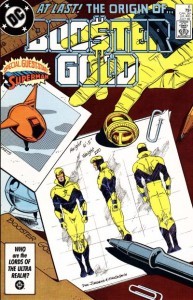 I’ve always had a soft spot for Booster Gold. And if you’re not a regular comic reader, you’re probably asking, “Booster who? What?”
I’ve always had a soft spot for Booster Gold. And if you’re not a regular comic reader, you’re probably asking, “Booster who? What?”
Booster Gold debuted in the mid-80s, and creator/writer/artist Dan Jurgens immediately distinguished him from the rest of DC’s superhero lineup. While most superheroes save the day for altruistic reasons or to avenge loved ones, Booster is pretty much in it for his own glory at first. He wants to be rich, famous, and adored. His path to doing so just happens to be crimefighting, but he’s totally comfortable marketing his likeness as any popular athlete would.
Jurgens could easily have misfired with this. (Well, the series lasted all of two years, so perhaps it was a misfire anyway. But the character was a creative success, and Booster has continued to play a role in the DC Universe ever since.) Booster could have come across as overly selfish and unlikeable—and at times he absolutely does—but beneath all the product endorsements and preoccupation with image, he’s a guy who truly wants to be the best superhero he can be.
As we learn in #6, his origin issue, Booster’s past is not one to be proud of. He starts from a very low point, and he’s determined to become something better.
To drive home just how un-heroic Booster initially appears, the big man himself, Superman, shows up and heaps considerable judgment upon the titular showboat. The two make for excellent foils.
Some heroes are born great, and others have to work hard at it. The latter is often the more interesting approach, and that’s what makes Booster Gold a somewhat hidden gem among DC’s cast.
Writer/Penciler: Dan Jurgens
Inker: Mike De Carlo
Publisher: DC Comics
How to Read It: back issues; Comixology
Appropriate For: ages 10 and up
June 27, 2016
Today’s Super Comic — Catwoman #12 (2002)
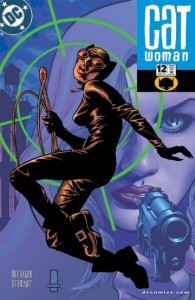 Catwoman has had quite a few solo series over the years, but none was better than Ed Brubaker’s noir take on the character, particularly in the first two years when the late, great Darwyn Cooke set the artistic tone.
Catwoman has had quite a few solo series over the years, but none was better than Ed Brubaker’s noir take on the character, particularly in the first two years when the late, great Darwyn Cooke set the artistic tone.
Cooke’s clean, energetic style freed poor Selina from the over-objectification she’s often subjected to. This series was never about cheesecake—it was about a unique woman, one comfortable in morally gray areas, trying to do her part to improve her neighborhood. Cameron Stewart soon took over the art, and he admirably continued the general look and feel that Cooke established.
Issue #12 kicks off what’s arguably the pinnacle of the run. It’s a relatively quiet issue that spends quality time with the supporting cast, which Brubaker did an excellent job of fleshing out. That effort went a long way toward making Catwoman feel like the center of her own world rather than an extension of Batman’s.
And when faces from the past return to Selina’s life, we can trust that Brubaker and Stewart will be sending us on a thrilling ride. And yes—the next several issues fulfill that promise.
Catwoman at her best, no Batman necessary.
Writer: Ed Brubaker
Artist: Cameron Stewart
Publisher: DC Comics
How to Read It: back issues; Comixology; Catwoman vol. 2: No Easy Way Down (TPB)
Appropriate For: ages 14 and up
June 26, 2016
Today’s Super Comic — 52 #42 (2007)
After decades as a C-list comic relief superhero, the Elongated Man finally has his moment.
And that’s basically what the weekly 52 series was all about. Superman, Batman, and Wonder Woman were absent for a year of DC’s continuity, allowing other characters time in the spotlight, such as Booster Gold, Renee Montoya, Animal Man, and others, even strechy guy Ralph Dibny. Different storylines featured different characters, showcasing various aspects of the DC Universe throughout the course of the year. The 52-issue series was quite an achievement in rapidly produced serialized storytelling (even if it did lead to the company’s obsession with the number 52), giving us lots of fantastic issues along the way.
While most issues made room for multiple storylines, issue #42 is almost entirely given to the climax of Ralph’s arc. And it’s a tremendous payoff that demonstrates why the Justice League kept the silly stretchy around for so many years, as a grief-stricken Elongated Man is able to employ his considerable detective skills to outwit a particularly powerful opponent.
Very nice to see a perennial C-lister get to shine, and to see an underdog triumph.
But don’t start with this issue—read the whole series.
Writers: Geoff Johns, Grant Morrison, George Rucka, Mark Waid
Layouts: Keith Giffen
Artist: Darick Robertson
Publisher: DC Comics
How to Read It: back issues; Comixology; 52 vol. 4 (TPB)
Appropriate For: 12 and up

